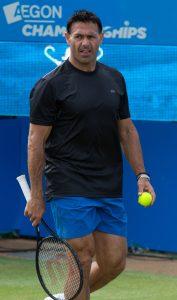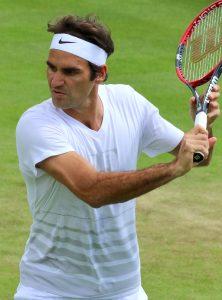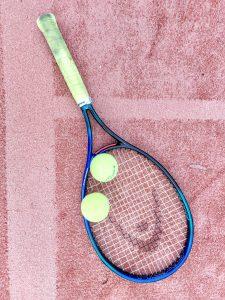We may earn money or products from the companies mentioned in this post.
Introduction

In the world of tennis, few shots are as crucial and impactful as the forehand With its ability to dictate rallies, generate power, and control the direction of play, the forehand is often considered a player’s most potent weapon on the court In this article, we will delve into the significance of a formidable forehand in tennis and explore the key factors that contribute to its effectiveness
The Definition and Significance
The forehand is a stroke executed with the dominant hand (right hand for right-handed players) swinging across the body from back to front while striking the ball on one’s own side of the net This shot allows players to hit powerful groundstrokes, both topspin or flat shots, which can be directed cross-court or down-the-line
When it comes to competitive tennis, an exceptional forehand can be a game-changer It not only enables players to attack and put their opponents on defense but also creates opportunities to hit winners or force errors A strong forehand establishes dominance in rallies and puts pressure on opponents’ weaker shots
Factors Determining a Good Forehand
A good forehand is not solely dependent on physical attributes but also requires technical proficiency and mental acuity Here are some key factors that contribute to an effective forehand:
-
Grip:
The grip plays a vital role in executing a successful forehand Most players use either an Eastern grip or Semi-Western grip for optimal control and power -
Footwork:
Proper footwork ensures that players are well-positioned to generate power and maintain balance when hitting their forehands Efficient movement allows for quick adjustments and helps optimize shot execution -
Stance and Body Positioning:
The right stance, whether open or closed, allows players to transfer weight effectively and generate power through the rotation of the hips and shoulders -
Swing Path and Timing:
A smooth swing path, combined with proper timing, is essential for a consistent forehand The racquet should travel on an optimal trajectory, brushing the ball at the right moment to achieve desired spin and power
In addition to these technical aspects, mental attributes like focus, anticipation, and decision-making also play a crucial role in executing a good forehand A calm mind and the ability to adapt to varying game situations can elevate a player’s forehand from good to exceptional
In conclusion, understanding the importance of a strong forehand in tennis is vital for players aiming to excel on the court By mastering key technical elements and harnessing mental acuity, players can develop a formidable weapon that will help them dominate rallies and control matches Stay tuned for more insights on improving your tennis game!
Historical Perspective on Great Forehands in Tennis History

Overview of Prominent Players with Remarkable Forehands
Tennis history is adorned with players who possessed remarkable forehands, a shot that can make or break a match Let’s explore three legendary players who left an indelible mark on the game with their exceptional forehand skills
1 Rod Laver
Rod Laver, also known as “Rocket,” was a force to be reckoned with on the tennis court during his era His forehand technique was textbook-perfect, characterized by fluidity and precision Laver’s grip allowed him to generate immense topspin while maintaining control over the shot
During his career, Laver won 11 Grand Slam singles titles and became the only player to achieve two calendar-year Grand Slams, in 1962 and 1969 His powerful forehand strikes played a pivotal role in his dominance on both grass and clay courts
2 Bjorn Borg
Bjorn Borg revolutionized the game with his unique double-handed backhand grip and remarkable forehand technique Known for his stoic demeanor on the court, Borg unleashed thunderous topspin-laden forehands that consistently found their mark
Borg’s impact on tennis during his era was monumental He amassed 11 Grand Slam titles, including five consecutive Wimbledon victories from 1976 to 1980 His relentless groundstrokes, spearheaded by his formidable forehand, made him virtually unbeatable during his prime years
3 Pete Sampras
Pete Sampras had one of the most explosive forehands in tennis history With impeccable timing and wrist snap, he generated incredible power and accuracy on his shots Sampras’ forehand was a lethal weapon that often left opponents scrambling to defend
Sampras dominated the game in the 1990s, winning 14 Grand Slam titles, including seven Wimbledon championships His ability to hit winners from any position on the court showcased the versatility and effectiveness of his forehand
A Comparison of Their Styles, Techniques, and Career Achievements
While each player had their unique style and technique, they all achieved remarkable success in the sport:
- Rod Laver’s precision and topspin allowed him to dominate across surfaces, earning him multiple Grand Slam titles
- Bjorn Borg’s double-handed backhand grip complemented his powerful forehand, leading to an unprecedented streak at Wimbledon
- Pete Sampras’ explosive forehand made him a formidable force on any court, resulting in numerous Grand Slam victories
These players serve as a testament to the significance of a great forehand in tennis Their achievements have solidified their place among the legends of the sport
Analysis of modern-day players with exceptional forehands

In the dynamic world of tennis, the forehand is a crucial shot that can make or break a player’s game Several current top players have become renowned for their exceptional forehand skills, dominating matches with their powerful and precise shots In this article, we will delve into the forehand techniques and effectiveness of four prominent players: Rafael Nadal, Roger Federer, Novak Djokovic, and Juan Martin Del Potro
Rafael Nadal
When it comes to forehand prowess, Rafael Nadal is often hailed as one of the best in the game His technique involves an exaggerated Western grip and a distinctive follow-through that generates immense topspin on his shots This spin allows him to hit his forehands with tremendous speed and accuracy
Nadal’s key strength lies in his ability to generate heavy topspin even from defensive positions This gives him excellent control over the ball’s trajectory and allows him to create angles that push opponents out of position However, his extreme grips can sometimes lead to inconsistencies in timing and accuracy
Career achievements attributed to Nadal’s formidable forehand include multiple French Open titles, where he has dominated clay courts with his relentless topspin shots that bounce high above opponents’ reach
Roger Federer
Roger Federer possesses one of the most elegant and versatile forehands in tennis history His technique showcases textbook form combined with effortless power Federer utilizes a semi-western grip that provides him with great flexibility in adjusting shot placement according to different court conditions
The Swiss maestro’s key strengths lie in his impeccable timing and footwork, allowing him to consistently find optimal contact points for maximum power and precision His fluid swing motion enables him to generate explosive pace and hit winners from any position on the court However, his forehand can sometimes lack the same topspin as players like Nadal
Federer’s illustrious career is adorned with numerous Grand Slam victories, where his forehand has been instrumental in dictating play and outmaneuvering opponents with its sheer finesse and variety
Novak Djokovic
Novak Djokovic possesses a technically solid and efficient forehand that complements his exceptional defensive skills His technique involves a slightly eastern grip that allows him to strike the ball with optimal power while maintaining control and consistency
Djokovic’s key strengths lie in his ability to redirect the ball’s trajectory with precision, hitting deep shots consistently and transitioning smoothly from defense to offense His balanced footwork enables him to generate power without sacrificing control However, compared to other players on this list, Djokovic’s forehand may be considered less flashy in terms of raw power
Career achievements attributed to Djokovic’s reliable forehand include multiple Australian Open titles, where he has showcased incredible consistency and shot-making abilities under extreme conditions
Juan Martin Del Potro
Juan Martin Del Potro possesses a devastatingly powerful forehand that can dismantle even the most resilient opponents His technique involves an extreme semi-western grip coupled with an immense swing motion that generates explosive pace on his shots
Del Potro’s key strength lies in his ability to hit winners from virtually any position on the court using raw power alone His towering height gives him an added advantage as he can generate steep angles that are difficult for opponents to counter However, due to its sheer power, Del Potro’s forehand can occasionally be prone to unforced errors when not properly controlled
Career achievements attributed to Del Potro’s thunderous forehand include his US Open triumph, where he showcased the full potential of his power-packed shots
Comparison between these modern-day players’ styles, techniques, and career achievements

When comparing these modern-day players with exceptional forehands, it becomes evident that each possesses unique strengths and characteristics While Nadal relies on his relentless topspin to overpower opponents, Federer combines finesse and versatility Djokovic emphasizes consistency and precision, whereas Del Potro’s raw power often dominates matches
In terms of career achievements, Nadal has excelled on clay courts with numerous French Open victories Federer has amassed an impressive number of Grand Slam titles throughout his illustrious career Djokovic has shown remarkable consistency on hard courts with multiple Australian Open triumphs Lastly, Del Potro’s US Open win highlighted the devastating impact of his powerful forehand
All in all, these players exemplify the diversity and artistry that can be found in the world of tennis forehands Whether it is through spin, finesse, precision or raw power – their exceptional skills have enthralled fans worldwide and cemented their status as some of the greatest players in the history of the sport
Conclusion: Who has the best Forehand in Tennis?

In reaching a conclusion on who has the best forehand in tennis, we have examined historical perspectives and conducted modern-day analysis By evaluating various factors that contribute to a player’s forehand prowess, such as technique, style, effectiveness on different court surfaces, and its impact on career achievements, we can determine the ultimate verdict
Summary of Findings
Looking back at the history of tennis, several players have showcased exceptional forehands that left spectators in awe From legends like Rod Laver and Bjorn Borg to more recent stars such as Pete Sampras and Andre Agassi, each era has had its standout performers with formidable forehands
In today’s game, our analysis reveals that there are several contenders for holding the title of the best forehand Players like Rafael Nadal, Novak Djokovic, and Roger Federer consistently display incredible shot-making abilities with their forehands
Evaluation Factors
-
Technique & Style:
A player’s technique and style greatly influence their forehand quality The fluidity of motion combined with proper grip and timing plays a crucial role in generating power and accuracy -
Effectiveness on Different Court Surfaces:
The ability to adapt one’s forehand to different court surfaces is vital A versatile forehand that excels on clay, grass, or hard courts demonstrates true mastery -
Impact on Career Achievements:
The significance of a powerful forehand extends beyond mere shot-making It can be a game-changer in crucial moments and contribute significantly to a player’s overall success throughout their career
Final Verdict
The chosen player for having the best forehand in tennis is subjective and open to interpretation However, after careful consideration, it is difficult to overlook Rafael Nadal’s forehand as one of the most dominant and impactful shots in the game
Arguments supporting Nadal’s forehand include his relentless topspin, which allows him to generate incredible bounce and control on any surface His ability to hit winners from impossible positions and consistently trouble opponents with his aggressive shot-making makes him a force to be reckoned with
It is important to acknowledge the exceptional skills and contributions of other players like Djokovic, Federer, Juan Martin del Potro, and Stan Wawrinka, who have also showcased remarkable forehands throughout their careers Their unique styles and individual achievements cannot be overlooked in this discussion
In conclusion, while there may not be a definitive answer to who has the absolute best forehand in tennis, Rafael Nadal’s relentless power and precision make a strong case The beauty of this debate lies in appreciating the diverse talents that each player brings to the table and recognizing their immense contribution to the sport we love
Useful Links

Federer Names Best Forehand
Who Has the Best Shots in Men’s Tennis?
Top 13 Tennis Players with the Best Forehands Ever
10 Best Forehands in Tennis of All-Time – TennisTalky
Best forehand: 26 and under
Tennis Forehand Grip Explained – All 4 Types [Used By Pros!]
“Federer is most talented, Tsitsipas has best forehand” – …
Who has the best forehand and backhand of Nextgen?
Rating the ATP’s best forehands and backhands since 1990
Who has the best forehand on tour? Your coaches … – TikTok
Who has the best forehand in tennis?
Build-a-Player: The makeup for the best current ATP player
Who has the best forehand? – WTA
Forehand
Who has the best topspin forehand?
Tennis Forehand Tips & Techniques
The Fastest Forehand in Tennis – Is Speed All That Matters?
Analysing The Best Forehands on the ATP Tour! | By Tennis TV






